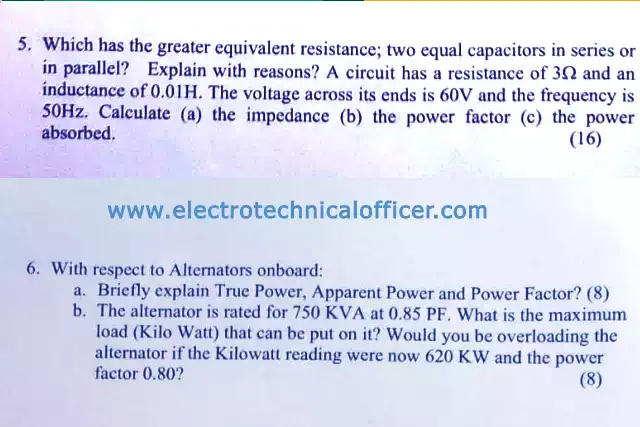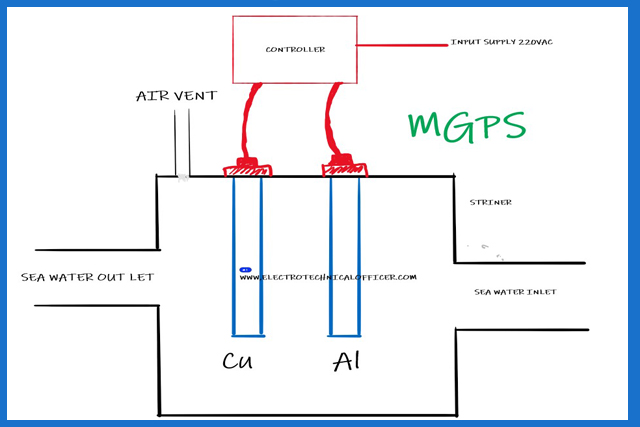SOLVED NUMERICAL QUESTIONS IN ASKED IN ETO COC WRITTEN EXAM - PART I
Let me remind the basic electrical formula
BASIC FORMULAS FOR 3 PHASE AC MOTOR
SLIP
S
= (Ns
- N)
/ Ns
or
fr / fs
Where
Ns
is synchronous speed
N
rotor speed
fr
is Rotor frequency = x/60
fs
is supply frequency
STATOR INPUT P1
P1
= P2
+ PF
+ PCS
(Rotor input + stator losses)
Where
P2
is Rotor input
PF
is stator core loss
PCS
is stator copper loss
ROTOR INPUT P2
Rotor
input P2
= Pm
/
(1-S)
Where
Pm
is Rotor gross output
Or
P2
= P1
– Stator loss
ROTOR GROSS
OUTPUT Pm
Pm
= Pout
+ Pw
Where
Pout
is motor or rotor output
Or
Pm
= P2
– Rotor loss
Where
Or
Pm
= Tg
x ωr
Where
Tg
is gross Torque
Tg
= Tsh
+ Torque loss
Where
Tsh
is shaft torque
ωr = (2Nr) / 60 or 2nfL ; here nfL = NfL / 60 and Nr = Ns (1-S)
Where Nr is rotor speed or actual speed
NET MECHANICAL OUTPUT OR SHAFT OUTPUT OR MOTOR OUTPUT
OR ROTOR OUTPUT
Pout
= Pm
– Pw or Pout
= Tsh
x ωr
EFFICIENCY
ղ
%
= (Pout
/
P1) X 100
ROTOR CU LOSS
Rotor Cu Loss = S x P2
Where
S is SLIP
P2 is Rotor input
FREQUENCY OF
ROTOR CURRENT
fr
= Sf
x F
Where
Sf
is Slip at frequency
F
is supply frequency
ETO COC CHAPTERWISE SOLVED NUMERICALS
CHAPTER 1: 3 PHASE AC
MOTOR
1.1) Question: The shaft
output of a three-phase 60- Hz induction motor is 80 KW. The friction and
windage losses are 920 W, the stator core loss is 4300 W and the stator copper
loss is 2690 W. The rotor current and rotor resistance referred to stator are
respectively 110 A and 0.15 Ω. If the slip is 3.8%, what is the percent
efficiency? (Apr, Aug 2016)
Solution:
Shaft output (Pout) = 80 KW
Windage and Friction losses (Pw) = 920W
Stator core
loss (p.f.) = 4300 W
Stator copper loss (Pcs) = 2690W
Slip (s) = 3.8% =
0.038
Rotor Gross output (Pm) = Pout + windage and friction
losses
= 80 KW + 920 W
= 80.92KW
Rotor gross output (Pm)/ Rotor Input (P2) = 1–s
80.92/P2= 1-0.038
= 0.962 P2
= 80.92/0.962 = 84.11 KW
We know that;
Stator input (P1) = rotor input (P2) + stator core loss
(Pf) + stator cu loss (Pcs)
= 84.11 KW +4300 W + 2690 W
= 91.1 KW
% Efficiency (% η) = (rotor output / stator input) x
100
= (Pout/P1) x 100
= (80/91.1) x 100
Answer: % of Efficiency = 87.81%
1.2) Question: The power
input to a 500 V, 50 Hz, 6 pole 3 phase squirrel cage induction motor running
at 975 rpm is 40 KW. The stator losses are 1 KW and the friction and windage
losses are 2 KW.
Calculate
(i) Slip
(ii) Rotor copper loss
(iii) Mechanical power
developed
(iv) The efficiency.
(MAR 2015, JUN 2015
& JUN 2016)
Solution:
(i) Rotor Speed (N) = 975 RPM
Synchronous speed (Ns) = 120 f /P
= 120 X 50/6 = 1000 RPM
Slip (s) = (Ns-N)/Ns
= (1000-975)/ 1000
= 0.025
(ii) Stator Input (P1) = 40 KW,
Stator Output or Rotor Input (P2) = P1-Stator loss
= 40
-1 = 39KW
Rotor copper loss = s x P2
= 0.025 x 39
= 0.975KW
(iii) Gross mechanical output (Pm) = P2 – Rotor Cu loss
= 39 - 0.975 = 38.025KW
Net mechanical output or Shaft output (Pout) =Pm -
friction and winding loss
= (38.025-2.000) KW
= 36.025KW
(iv) Efficiency % (% η) = (Pout x 100)/ P1
= (36.025 x
100) /40
= 90.06 %
Note: Assume that the core loss is included in friction
and windage loss and the total loss under this head is 2 kW.
Answer:
(i) Slip = 0.025
(ii) Rotor copper loss = 0.975KW
(iii) Mechanical power developed = 36.025KW
(iv) The efficiency = 90.06 %
1.3) Question: A 400V,
4-pole, 50 Hz, 3-phase, 10 Hp, star connected induction motor has a no-load
slip of 1% and full load slip of 4%. Find the following:
(i) Syn. speed (ii)
no-load speed (iii) full-load speed.
(iv) Frequency of
rotor current at full-load (v) full-load torque. (JUL 2016, OCT 2017)
Given Data:
VL = 400 volts
P = 4 nos
50 Hz
Po = 10 HP = 735.5 x 10 = 7355-watt (For British unit 1
(B) HP = 746 W)
Solution:
(i) Synchronous speed Ns = 120 f / p
= 120 x 50 / 4
=
1500 rpm
(ii) No load speed at slip s = 0.01
No = Ns (1 – s)
= 1500 (1- 0.01)
= 1485 rpm
(iii) Full load speed at slip sf = 0.04
Nfl = Ns (1-sf)
= 1500 (1-0.04)
= 1440 rpm
(iv) Frequency of rotor current (fr) = sf. f = 0.04 x
50 = 2.0 Hz
(v) Full load torque at shaft
TSh = 9.55 Po / Nfl
= 9.55 x 7355 /1440
= 48.78 Nm
Answer:
(i) Syn. Speed = 1500 rpm
(ii) No-load speed = 1485 rpm
(iii) full-load speed = 1440 rpm
(iv) Frequency of rotor current at
full-load = 2.0 Hz
(v) full-load torque 48.78 Nm
1.4) Question: A 3 phase
Induction Motor which is wound for 4 pole, when running full load develops a
useful torque of 100 Nm; also rotor emf is observed to make 120 cycles/ min. It
is known that the torque lost on account of friction and core loss is 7 Nm.
Calculate the shaft Power output, Rotor cu loss, Motor Input and Efficiency.
(SEP & OCT 2016, FEB 2018)
Given Data:
Shaft Torque Tsh = 100Nm &
Rotor frequency fr= 120 / 60 = 2 Hz
Solution:
Assume supply frequency is 50 Hz, so, fs = 50Hz
Slip s
= fr/fs = 2/ 50
=0.04
Synchronous speed Ns = 120f/p
= 120x50/4
= 1500 rpm
Rotor speed Nr = (1-s) Ns
= (1 – 0.04) x 1500
= 1440 rpm
Rotor’s radian speed
ωr = 2 π X1440 / 60
= 150.7 rad/s
Shaft power output Pout = Tsh x ωr
= 100 x 150.7
=
15.07 KW.
Gross Torque Tg = Tsh + Torque loss
= (100+7)
= 107Nm
Also, Tg = Pm/ωr
or, Rotor gross output Pm = Tg x ωr
= 107 x 150.7
=
16.12kW
Rotor Input P2 = Pm/(1-s)
= 16.12/(1-0.04)
= 16.12/0.96
= 16.79kW
So, Rotor copper loss = s x P2
= 0.04 x 16.79
= 0.67 kW
Motor Power input Pin = P2 + Stator Cu Loss
= 17.49 kW.
(Assume Stator Cu Loss = 0.7 KW)
% Motor efficiency (η) = (Shaft Power Output/ Motor
Power Input) x 100
= (Pout/Pin) x 100
= (15.07 / 17.49) x 100 = 86.16 %
Answer:
Shaft Power output = 15.07 KW
Rotor Cu loss = 0.67 kW
Motor input = 17.49 kW
Efficiency = 86.16 %
1.5) Question: The
output of an induction motor running at 4% slip is 36.775kW and the friction
and windage losses are 1500W. Find the rotor copper loss and motor efficiency
if stator losses are 3 kW. (10 Marks) (Jan, Apr 2019)
Solution:
Shaft output (Pout) = 36.775 KW
Windage and Friction losses (Pw) = 1500W = 1.5 KW
Stator loss = 3 KW
Slip (s) = 4% = 0.04
Rotor Gross output
(Pm) = Pout + windage and friction losses
= 36.775 KW + 1.5 KW = 38.275KW
Rotor gross output
(Pm)/ Rotor Input (P2) = 1–s
38.275/P2= 1-0.04=0.96
P2= 38.275/0.96 = 39.87 KW
Rotor copper loss = s
x P2
= 0.04 X 39.87 =
1.595KW
(Alternate Method: Rotor Copper Loss = Rotor Input (p2)
– Rotor Gross Output (Pm))
We know that;
Stator input (P1) =
rotor input (P2) + stator loss
= 39.87 KW + 3KW = 42.87 KW
% Efficiency (% η) = (rotor output / stator input) x
100 = (Pout/P1) x 100
= (36.775/42.87) x 100
= 85.78%
Answer:
Rotor copper loss = 1.595KW
Motor efficiency = 85.78% (when stator
losses are 3 kW)
1.6) Question: If a
6-Pole motor is supplied at 60Hz and runs with a slip of 5%, what is the actual
Rotor Speed? (4 marks) (Aug, Sep 2018, Mar 2019)
Given Data:
Given That f = 60 Hz
Slip% = 5%
No. of poles P = 6
Solution:
Synchronous speed
Ns = 120 f/P
= 120 x 60/6
= 1200RPM
Let Actual speed is
N,
Then, Slip% = {(Ns – N)/ Ns} *100
5 = {(1200 – N)/ 1200} * 100
6000/100 = 1200 – N
N = 1200 – 60 = 1140 RPM
Answer:
Actual Rotor speed = 1140 RPM
1.7) Question: A 3-phase
induction motor is wound for four poles and is supplied from a 50Hz system.
Calculate:
(i) The synchronous
speed,
(ii) The speed of the
rotor when the slip is 4%.
(iii) The rotor
frequency when the speed of the rotor is 600r/min. (10 Marks) (Jul 2019)
Solution:
(i) Synchronous speed Ns = 120 f/P = 120x50/4 =1500rpm
(ii) Rotor Speed N = Ns (1-s) = 1500 (1 – 0.04) =
1500x0.96 = 1440rpm
(iii) If Rotor Speed N = 600rpm
Then slip s = (Ns – N)/Ns = (1500 -600)/ 1500 = 0.6 So,
Rotor current frequency f’ = s.f = 0.6x50 = 30 Hz
Answer:
(i) Synchronous speed Ns =1500rpm
(ii) Rotor Speed N = 1440rpm
(iii) The rotor frequency when the speed
of the rotor is 600r/min = 30 Hz
CHAPTER 2: DC MACHINES
(MOTOR AND GENERATOR)
2.1) Question: A shunt
generator has an induced emf of 254 V. When the generator is loaded, the
terminal voltage is 240 V. Neglecting armature reaction, find the load current
if the armature resistance is 0.04 ohm and the field circuit resistance is 24 ohms. (Apr, Aug
2016)
Given Data:
Eg = 254 V
V = 240 V
Ra = 0.04 Ω
Rsh = 24 Ω
Solution:
Ish = V / Rsh = 240/24 = 10A.
Substituting the values in the below expression,
Eg = V + Ia Ra
Eg = V + (IL + Ish) Ra
254 = 240 + (IL + 10) 0.04
Answer: LOAD CURRENT = 340A
2.2) Question: A 220 V
Shunt Motor takes 5 A at No load. Armature resistance is 0.25 Ohm and Field
Resistance is 200 ohm.
Calculate
(i) Efficiency when
taking Full Load current of 50A
(ii) % Changes in
Speed between No load to Full Load (MODEL PAPER 2015)
Solution:
(i)
No Load Io = 5 A,
Ra = 0.25 ohm
Full Load IL = 50 A,
Rsh = 200 ohm
Field current Ish = 220/200 = 1.1 A
No Load Ia = 5-1.1=3.9 A
Full load Ia = 50-1.1 = 48.9 A
No Load Power I/P = 220x5 = 1100 W
Full load Power I/P = 220x 50 = 11000W
No Load Armature Loss = Ia2 Ra = 3.9 x 3.9 x
0.25 =3.8 W
Constant Loss = N/L Power – N/L Ia2 Ra loss
= 1100-3.8 = 1096.2 W F/L
Armature Cu Loss = Ia2 Ra = 48.9 x 48.9 x 0.25 = 597.8
W
Total F/L Losses = Constant Loss + F/L Armature Cu Loss
= 1096.2 + 597.8 = 1694 W F/L Power Output = 11000-1694 = 9306W
% Efficiency at 50 A F/L current = (9306/11000) x 100 =
84.6 %
(ii) %
Changes in Speed between No load to Full Load
Ebo = V - IaRa
= 220 – 3.9 x 0.25
= 220- 0.975 = 219.025V
Eb = V - IaRa
= 220 – 48.9 x 0.25
= 220 – 12.225
= 207.775V
We know that;
% Changes in Speed between No load to Full Load = [(No–Nfl )/ ] x 100
= [(219.025–207.775)
/ 207.775]
x 100
= 5.41%
Answer:
(i) The Efficiency is 84.6 % when taking Full Load current of 50A
(ii) % Changes in Speed between No load to Full Load = 5.41%
2.3) Question: Two DC
Shunt Generators are connected in parallel and supply a load to DC shunt motor
taking a current of 150 A. One generator emf of 250 V and has an armature
resistance of 0.2 Ohm and the other has 255 V with an armature resistance of
0.3 ohm. What is the motor output voltage and power output of each generator?
(Neglect field current) (JULY 2016 & SEP 2015)
Let Motor Output voltage = V
Load Current IL = 150 A
IL = Ia1+Ia2 = 150 A
So, Ia2 = 150- Ia1 -----------
(1)
Now,
In Gen 1,
V = E1- Ia1 Ra1
= 250 – 0.2 Ia1 --------------- (2)
And,
In Gen 2,
V= E2- Ia2 Ra2
= 255- 0.3(150-Ia1)
= 255-45 + 0.3 Ia1
= 210 + 0.3 Ia1 ---------------- (3)
From eq. (2) & (3)
V = 250 – 0.2 Ia1 = 210 + 0.3 Ia1
0.5 Ia1 = 40
Ia1 = 40/0.5
= 80 A
So, Ia2 = 150- Ia1
= 150 - 80
= 70 A
Now Motor output voltage V = E1 – Ia1 Ra1
---------------- (2)
= 250 - 0.2 x 80
= 234 V
Power Output of First Generator = E1 x Ia1 = 250x 80 =
20 KW
Power Output of Second Generator = E2 x Ia2 = 255x 70 =
17.85 KW
Answer:
The motor output voltage = 234 V
Power Output of First Generator = 20 KW
Power Output of Second Generator = 17.85 KW
2.4) Question: Two
220V dc generators each having linear external characteristics, operated in
parallel. One machine has a terminal voltage of 270V on no-load and 220V at a
load current 35A, while the other has a voltage of 280V at no-load and 220V at 50A. Calculate the
output current of each machine and the bus bar voltage when the total load is
60A. What is the kW output of each machine under this condition? (AUG 2018, Nov
2018)
Solution:
Generator 1
No-load voltage = 270V
Full-load voltage = 220V
Full-load current = 35A
Voltage drop for 35A = 270V - 220V = 50V
Therefore Voltage drop/Amp of output current
50V / 35A = 1.429V/A
So, R1 = 50V/35A
= 1.43 Ohm
Generator 2
No-load voltage = 280V
Full-load voltage = 220V
Full-load current = 50A
Voltage drop for 50A = 280V - 220V = 60V
Therefore Voltage drop/Amp of output current
60V / 50A = 1.2V/A
So, R2 = 60V/50A
= 1.2 Ohm
Let V = bus-bar voltage
I1 = current output of generator 1
I2 = current output of generator 2
Then V = 270 – 1.43 I1------------- for Gen 1
& V = 280 – 1.2 I2 ------------------for
Gen 2
Also, I1 + I2 =
60A
Ia2 = 60A - Ia1
To operate in parallel both generator terminal Voltages
must be equal under the 60 Amp total load current. Therefore;
270V - 1.43 I1 = 280V - 1.2 I2 or
270 - 1.43 I1 = 280 - 1.2(60 - I1)
2.63 I1 = 62
So, I1 = 23.57 Amps
&, I2 = 60 - 23.57
= 36.43 Amps
Now bus Voltage V = 270 – 1.43 I1 = 236.29 Volts
Generator 1 output power = V * I1 = 236.29 *23.57 =
5.57 kW
Generator 2 output power = V * I2 = 236.29 * 36.43 =
8.60 kW
Answer:
Generator 1 output power = 5.57 kW
Generator 2 output power = 8.60 kW
Solved by The senior Electro Technical Officer Mr. Mobin ETO
Next Part> Chapter 3, 4, 5 and 6


















3 Comments
Really usefull...thanks alot for all these questions
ReplyDeleteappreciated
ReplyDeleteThank you brother very useful information..
ReplyDeleteThanks again for the question & Answers..
We love to hear your comments on this article, so that we may better serve you in the future.